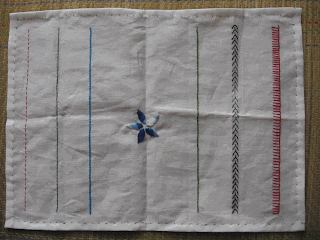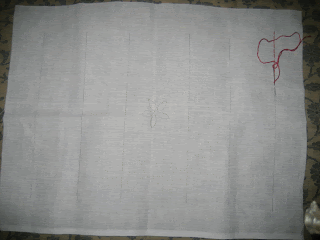I am giving below details on some popular varieties of Indian embroidery. The limit to the variety to the art of embroidery is the limit to the human mind’s creativity. So it is very difficult to categorize exhaustively. Still, depending upon the repeating basic patterns used, embroidery can be classified for our own understanding and identification.
Kasuthi
Chikankari
Chikankari embroidery is centered in Uttar Pradesh, mainly Lucknow. It is worked mostly with double back stitch (which we may call herringbone stitch worked on the wrong side) and with white thread. Other stitches used are stem stitch, eyelet stitch and French knots. When Chikankari is worked in a semi transparent or transparent fabric like the mulmuls or muslin, it gives a shadow effect on the facing side of the fabric and we call it the shadow embroidery. This gives a wonderful effect when worked white thread and also in coloured threads. The following picture shows chikankari work on a kameez.
Kantha
Kantha embroidery is popular in West Bengal and Bangladesh. This exquisite form of embroidery is all made out of the simple running stitch. Other stitches used are darning stitch, satin and loop stitch. Stem stitch, back stitch or running stitch is used to outline motifs. Motifs used in kantha embroidery are human and animal figures and floral symbols. Kantha is an apt form of embroidery to represent Warli drawings too. This picture shows a motif from a kantha embroidered saree.
Kutch Embroidery
Kutch work is a unique form of embroidery done is parts of Gujarat. The stitches used are a unique form of interlacing stitch and herringbone stitch. Other simple stitches like stem stich and laisy daisy are used to give additional effects. Mirror work forms a main part of Kutch embroidery. This picture is the yoke of a kameez embroidered by me.
Phulkari
Phulkari, an embroidery technique from the Punjab in India and Pakistan literally means flower working, which was at one time used as the word for embroidery, but in time the word “Phulkari” became restricted to embroidered shawls and head scarfs. It is mostly done in long and short darn stitch. The following picture shows a phulkari embroidery piece I got from the Net.
Kashmiri
Kashmiri embroidery is also known as Kashida. It is a colorful and beautiful form of embroidery the designs of which mainly draws inspiration from the beautiful nature around. The motifs of flowers, creepers and chinar leaves, mango etc. are the most common ones. The whole pattern is created using one or two embroidery stitch styles. The commonly used stitches are chain stitch, satin stitch, the slanted darn stitch, stem, herringbone and sometimes the doori or knot stitches. But, at at time, only one or two stitches are used. See thsi example from the Net.
Hope you had a good reading; believe that the pictures delighted you.



































